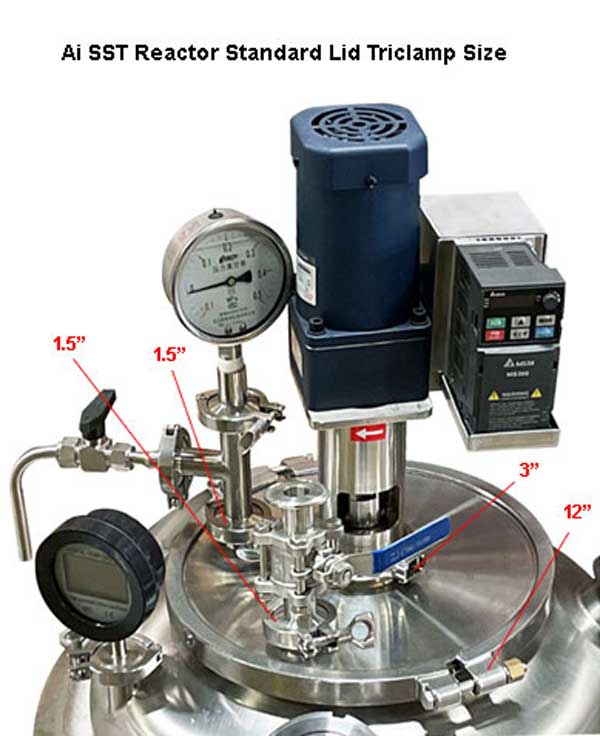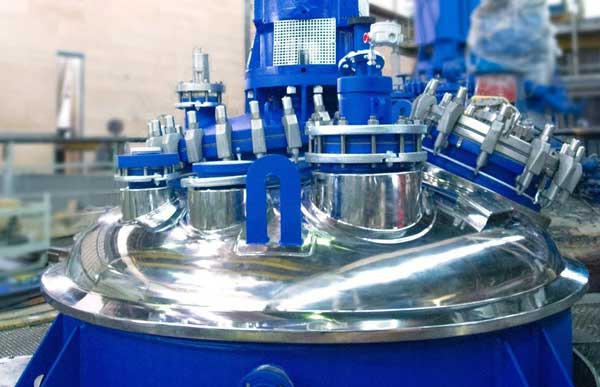Glass Lined Reactor Agitator Types And Question
Glass-lined has good corrosion resistance and has obvious cost advantages compared with stainless steel products of the same specification, so it is widely used in chemical, pharmaceutical and other industrial production fields. Most of the enamel glass reactor equipment provided by ZZKD has a relatively low operating pressure. Most of the glass reactor assembly are under normal pressure, and the operating pressure in the jacket is usually less than 0.2MPa. Some problems such as deformation and cracks appearing in use.
Among them, pharmaceutical companies have some characteristics that are different from other industries. Generally speaking, pharmaceutical companies are generally medium-to-high in scale and have relatively complete management. They have special personnel responsible for equipment procurement, maintenance and data preservation. Problems that often occur in the inspection of other types of pressure vessels, such as unlicensed operation by operators, and safety accessories not being calibrated over time.

1 Glass lined reactor agitator types
The stirrer is an important part of the glass phase reactor. A good stirrer can greatly improve the stirring efficiency, shorten the reaction time, and improve the yield and product quality of the finished product.
①Frame stirrer: The width of the frame is 0.9~0.98 times of the inner diameter of the kettle, which can prevent the material from adhering to the wall of the kettle.
②Anchor stirrer: When the anchor stirrer rotates, it almost touches the inner wall of the kettle body, which can scrape off the wall deposits in time, which is conducive to heat transfer. This type of mixer is suitable for stirring viscous materials, and the speed can be 15~80 r/min.
③Paddle agitator: The total length of the blades can be 1/3~2/3 of the inner diameter of the kettle. It should not be too long, and the speed can reach 20-80r/min.
④ Impeller agitator: The impeller agitator consists of several impellers mounted on a straight shaft. Its operation form is similar to the impeller of a centrifugal pump. When the turbine rotates, the liquid is sucked through the center along the shaft. Under the action of centrifugal force, it is thrown from the center to the edge of the turbine along the channel between the impellers, and is thrown out at a high speed along the tangential direction, while the Causes vigorous stirring. It is suitable for continuous stirring operation of a large amount of liquid, and can be used in almost any situation except for thick paste-like materials.
⑤ Combined agitator: The combined agitator consists of a paddle and an impeller at the same time.
The dislocation is installed on the straight shaft. high power consumption can be obtained at low power consumption
spin quickly.
2 The basic situation and reasons for judging the waste glass-lined reactor
2.1 Corrosion of metal substrates
Jacket corrosionCorrosion on the outer surface of glass-lined reactors is very common, and a large number of equipment that has not been judged to be scrapped generally suffer from corrosion exceeding the corrosion allowance. There are three main reasons why corrosion is so common and serious:
(1) Due to the needs of the production process, the glass-lined reactor needs to often pass chilled water in the jacket;
(2) The air humidity in coastal areas is high, and the volatile acid in the reaction kettle diffuses into the workshop after volatilization;
(3) The enterprise ignores the protection of the thermal insulation layer and the anti-corrosion layer, and fails to repair it in time or correctly after a problem occurs.
The above three points lead to the long-term maintenance of some technical substrates in a wet state. At the same time, the volatile acid in the workshop dissolves in the water film, which further aggravates the corrosion.
Corrosion of metal matrix in inner cylinder
Generally speaking, the parts of the inner cylinder of the glass-lined reactor that are in direct contact with the reaction materials are covered with a glass-lined layer. If the glass-lined layer is not damaged, the metal matrix of the inner cylinder will be well protected. Once the glass-lined layer is damaged, the highly corrosive reaction material will rapidly corrode the metal matrix of the inner cylinder.
Glass-lined layer damage
The problem of damage to the glass-lined layer is the most serious. Statistics show that more than 90% of the glass-lined reactors judged to be scrapped are due to the damage of the glass-lined layer, which does not meet the requirements. Once the glass-lined layer is damaged so that it cannot pass the 10kV DC high-voltage test, the glass-lined reactor will be directly judged as not meeting the requirements, which is also the main reason for the early scrapping of the glass-lined reactor.
smashed
The glass-lined layer has poor impact resistance, and any impact with hard objects may cause damage to the glass-lined layer. The damage caused by foreign objects is an important reason for the damage of the glass-lined layer. It is more common in the glass-lined layer of the lower head of the equipment. The brutal throwing of hard materials during production, and the accidental fall of various tools and nuts and bolts during maintenance will all lead to The glass-lined layer was smashed and damaged.
scratch
Scratches are the No. 1 cause of rejection in inspections, and their typical feature is that one or more scratches appear on the inner wall of the glass-lined reactor. The reasons are mainly in the following two situations:
(1) During the reaction process, the hard material or foreign matter is directly scratched with the surface of the glass-lined layer during the stirring process, resulting in scratches. Such scratches mainly appear in the middle or lower part of the inner wall of the glass-lined reactor barrel, usually a straight line that continues for a long time or even a whole circle.
(2) Workers use hard objects to clean materials improperly or use excessive force when cleaning materials. Such scratches generally appear on the lower head of the reactor, and are mostly dense scratches extending to the outlet of the reactor in a disorderly manner.
Charge breakdown
Mainly, the material with suspended solids is stirred in the glass-lined equipment, and the material and the glass-lined layer produce severe friction, and at the same time, the material itself is constantly rubbed. With the continuous stirring, the material itself accumulates a large amount of electrostatic charge, which will break down the glass-lined layer, resulting in deep and small pinhole-like defects on the glass-lined layer, resulting in the damage of the glass-lined layer.
corrosion loss
Among the more than 200 glass-lined reactors tested, the glass-lined layer corroded and lost light in many cases, but there were relatively few cases where the corrosion was so severe that it failed to pass the 10 kV DC high voltage test. According to the different formulations of glass-lined materials, different glass-lined layers can have a good anti-corrosion effect on a variety of corrosive materials, but some substances are more corrosive to glass-lined materials and should be avoided. For example, most of the glass-lined reaction kettles in this inspection indicated that their medium requirements are that they can be all in aqueous solution except for hydrofluoric acid, concentrated phosphoric acid (concentration>30%, temperature ≥180 and pH>12, temperature>100¡æ A medium that is ionized (except chloride ions).

3 Precautions
3.1 Strengthen the inspection of anti-corrosion layer and thermal insulation layer
The user should pay attention to the inspection of the anti-corrosion layer and the thermal insulation layer. During the inspection, the damaged parts of the anti-corrosion layer should be cleaned in time for rust and anti-corrosion treatment. It is especially worth noting that part of the insulation layer needs to be removed to measure the thickness of the jacket during each regular inspection. After the inspection is completed, the user should repair the insulation and anti-corrosion layers in these parts in time and have to ignore it.
3.2 Strengthen the protection of the glass-lined layer in the tank during maintenance
During each maintenance, a thick enough and large soft pad should be placed on the bottom of the inner wall of the reactor to prevent tools or hard parts from directly impacting the glass-lined layer when falling in. Workers need to use a soft ladder to enter and exit the reactor, and maintenance personnel need to wear soft bottoms. Shoes so as not to damage the glass-lined layer.
3.3 It is strictly forbidden to dredge the blockage of the discharge port improperly
If the outlet of the glass-lined reactor is blocked, soft objects such as wooden sticks and rubber sticks can be used to dredge it. It is strictly forbidden to use metal or other hard objects to shovel the blocked glass-lined nozzle.
3.4 Pay attention to material delivery
For the occasion of solid particle feeding, pay attention to the feeding speed and stirring speed. During the daily inspection, you should listen to the glass-lined reaction kettle for abnormal vibration and sound.
3.5 Production according to design requirements
The user should strictly follow the requirements in the product quality certificate of the glass-lined reactor for production, and it is strictly forbidden to put the glass-lined reactor into a corrosive environment that does not meet the requirements.
Glass-lined reactors in pharmaceutical companies have their own characteristics in their reaction process and usage. The main failure modes in operation are metal corrosion and mechanical damage to the glass-lined layer. Inspectors should pay attention to the above problems and formulate targeted inspection measures during the regular inspection process, accurately find equipment defects, and promptly notify users and regulatory agencies. , to ensure safe production. To learn more about glass-lined reactors, please contact us online!